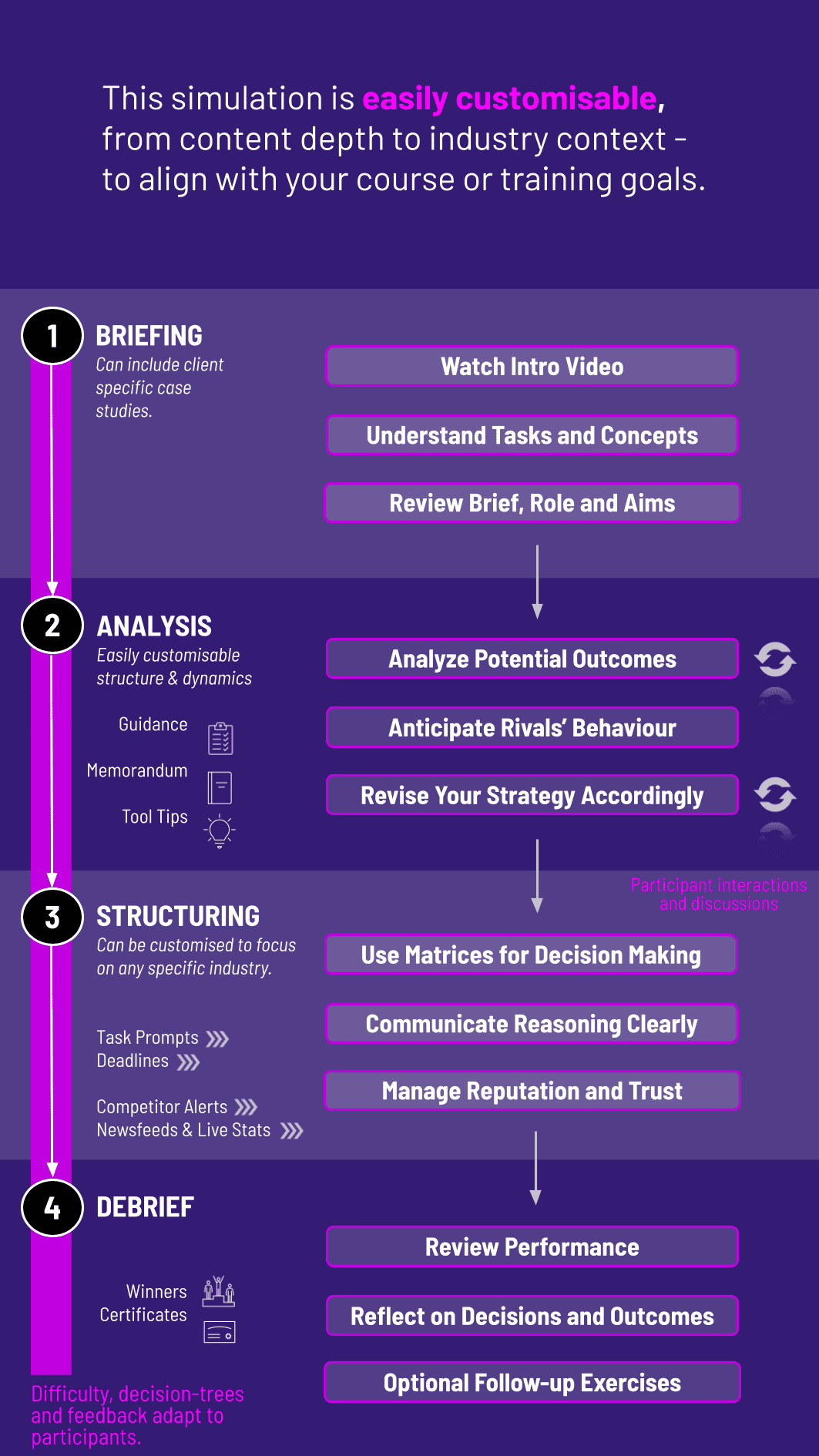
In this Game Theory Simulation, participants act as decision-makers navigating competitive and cooperative scenarios - using strategic reasoning, payoff analysis, and negotiation to anticipate rivals, align allies, and maximize outcomes under uncertainty.
Competitive vs cooperative strategy
Nash equilibrium and strategic stability
Prisoner’s dilemma and trust-building
Zero-sum vs positive-sum outcomes
Payoff matrices and decision trade-offs
Reputation and repeated interactions
Negotiation and coalition-building
Asymmetric information and signaling
Strategy under uncertainty
Applications to pricing, markets, and regulation


Analyse payoff matrices and potential outcomes
Choose competitive or cooperative strategies
Negotiate with peers to form alliances or agreements
Respond to rivals’ moves in iterative rounds
Manage trust, reputation, and credibility
Reflect on how game theory shapes real-world decision-making
By the end of the simulation, participants will be able to:
Apply game theory models to business and economic decisions
Understand the trade-offs in cooperation vs competition
Use payoff analysis to anticipate rival behaviour
Recognise the role of trust and reputation in repeated games
Develop negotiation skills in multi-party settings
Identify equilibria and strategic stability in dynamic contexts
Communicate reasoning clearly to allies and adversaries
Adapt strategies based on rival moves and feedback
Balance short-term gains with long-term relationships
Apply game theory across markets, pricing, and policy scenarios
The simulation’s flexible structure ensures that these objectives can be calibrated to match the depth, duration, and focus areas of each program, whether in higher education or corporate learning.
This simulation can run individually or in teams across academic and corporate contexts. Each cycle mirrors a strategic game with evolving payoffs and dynamics.
1. Receive a Scenario or Brief: Participants are introduced to a strategic dilemma with defined roles, goals, and payoff options.
2. Analyse the Situation: They evaluate possible outcomes using payoff matrices, probabilities, and rival incentives.
3. Make Strategic Decisions: Participants select strategies - competitive, cooperative, or hybrid—based on objectives and expectations.
4. Negotiate or Interact: In multi-party rounds, participants negotiate alliances, deals, or coordinated actions.
5. Review Results: Outcomes are revealed based on combined choices, with payoffs distributed according to the model.
6. Iterate and Reflect: Each new round introduces complexity (new rivals, repeated interactions, asymmetric information), requiring adaptation and reflection.
Do participants need prior knowledge of game theory? No. The simulation introduces concepts like payoff matrices and equilibria in an accessible way.
What types of scenarios are included? Pricing, market entry, partnerships, regulatory negotiations, and classic dilemmas like the prisoner’s dilemma.
Can it be run in teams? Yes. Teams negotiate and strategize together, mirroring real-world interdependence.
Does it cover repeated interactions? Yes. Reputation and trust in repeated games are central to the experience.
Is this suitable for executive programs? Yes. It helps leaders improve strategic and negotiation skills.
How long does the simulation take? It can be run in a 3-hour session or expanded across multiple classes.
Is it customizable? Yes. Scenarios can reflect industry-specific dilemmas or policy contexts.
Does it include negotiation exercises? Yes. Participants negotiate in coalitions or one-to-one settings.
Is it available online? Yes. The simulation supports online, hybrid, and in-person delivery.
How is performance measured? By payoffs earned, strategic alignment, and communication effectiveness.
Accuracy of payoff and strategic reasoning
Effectiveness in negotiation and coalition-building
Creativity in strategy development
Responsiveness to rival and ally actions
Communication clarity and persuasiveness
You can also include memo writing and debrief presentations as part of the assessment structure. Additionally, you can also add a built-in peer and self-assessment tool to see how participants rate themselves. This flexibility allows the simulation to be easily integrated by professors as graded courses at universities and by HR at assessment centres at companies.
Join this 20-minute webinar, followed by a Q&A session, to immerse yourself in the simulation.
or
Book a 15-minute Zoom demo with one of our experts to explore how the simulation can benefit you.